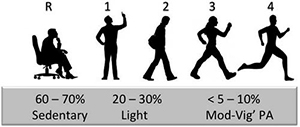Move, Stand at Work, New Recommendations
8/25/2015, American Institute for Cancer Research
Office workers should walk about and stand at least two hours over the course of the work day, building towards being up-and-about half the day (4 hours), according to one of the key recommendations by a panel of international experts.
The recommendations come in the form of a consensus statement published online in the British Journal of Sports Medicine. They were developed in response to a request by Public Health England and a UK community interest company (Active Working CIC) in response to the growing interest in making working environments more active. In this paper, sedentary is defined as time spent sitting. Standing or any movement at the office is considered light activity.
Based on the evidence the paper recommends:
-
2 hours daily of standing and light activity (light walking) during working hours, eventually progressing to a total of 4 hours for all office workers whose jobs are predominantly desk based
-
Regularly break up seated based work with standing based work, with the use of adjustable sit-stand desks/work stations Avoid prolonged static standing, which may be as harmful as prolonged sitting
-
Alter posture/light walking to alleviate possible musculoskeletal pain and fatigue as part of the adaptive process
-
Encourage staff to embrace other healthy behaviours, such as cutting down on drinking and smoking, eating a nutritious diet, and alleviating stress, employers should also warn their staff about the potential dangers of too much time spent sitting down either at work or at home

Proportion of weekly waking hours spent in activity modes.
Values represent gears as in a car (eg, reverse, gear 1). Engaging people in activity at gears 1 and 2 at work could help avoid sedentary behavior.
Source: Buckley JP. Et al. Br J. Sports Med
Researchers evaluated the available evidence based on the American College of Sports Medicine guidelines. The data is observational and largely retrospective, they note, but it provides intitial guidance that they hope will stimulate more research.
Many health promotion and physical activity interventions aim to change people’s behavior by attempting to go from Reverse to 3rd gear, the authors write. This can miss targeted interventions in 1st and 2nd gear, which could lead to “stalling” (relapse). Emerging evidence suggests that a first step to reduce inactivity could be to simply get people standing and moving more frequently as part of the work day, notes the paper.
Source: Buckley JP, Hedge A, Yates T, et al. The sedentary office: a growing case for change towards better health and productivity. Expert statement commissioned by Public Health England and the Active Working Community Interest Company. Br J. Sports Med Published Online. First: doi:10.1136/bjsports-2015-094618.
To view the original posting of this article, please go here.